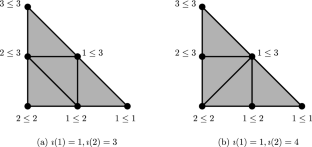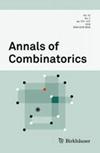关于多链配合物的同胚性和同伦型
IF 0.6
4区 数学
Q4 MATHEMATICS, APPLIED
引用次数: 1
摘要
本文对有限偏序集P定义和研究了P的r元多链集(P_r)上的一类单纯复形。该单纯复形依赖于从[r]到[2r]的严格单调函数。我们证明了正存在\(2^r)这样的函数,它们产生P的阶复形的细分,其中\(2^{r-1}\)是成对不同的。例如,在这一类中,有P中区间的阶复形,P的Z字形偏序集,以及P的阶复型的\(r{\hbox{th}})edgewise细分。本文章由计算机程序翻译,如有差异,请以英文原文为准。

On the Homeomorphism and Homotopy Type of Complexes of Multichains
In this paper we define and study for a finite partially ordered set P a class of simplicial complexes on the set \(P_r\) of r-element multichains of P. The simplicial complexes depend on a strictly monotone function from [r] to [2r]. We show that there are exactly \(2^r\) such functions which yield subdivisions of the order complex of P, of which \(2^{r-1}\) are pairwise different. Within this class are, for example, the order complexes of the intervals in P, the zig-zag poset of P, and the \(r{\hbox {th}}\) edgewise subdivision of the order complex of P. We also exhibit a large subclass for which our simplicial complexes are order complexes and homotopy equivalent to the order complex of P.
求助全文
通过发布文献求助,成功后即可免费获取论文全文。
去求助
来源期刊

Annals of Combinatorics
数学-应用数学
CiteScore
1.00
自引率
0.00%
发文量
56
审稿时长
>12 weeks
期刊介绍:
Annals of Combinatorics publishes outstanding contributions to combinatorics with a particular focus on algebraic and analytic combinatorics, as well as the areas of graph and matroid theory. Special regard will be given to new developments and topics of current interest to the community represented by our editorial board.
The scope of Annals of Combinatorics is covered by the following three tracks:
Algebraic Combinatorics:
Enumerative combinatorics, symmetric functions, Schubert calculus / Combinatorial Hopf algebras, cluster algebras, Lie algebras, root systems, Coxeter groups / Discrete geometry, tropical geometry / Discrete dynamical systems / Posets and lattices
Analytic and Algorithmic Combinatorics:
Asymptotic analysis of counting sequences / Bijective combinatorics / Univariate and multivariable singularity analysis / Combinatorics and differential equations / Resolution of hard combinatorial problems by making essential use of computers / Advanced methods for evaluating counting sequences or combinatorial constants / Complexity and decidability aspects of combinatorial sequences / Combinatorial aspects of the analysis of algorithms
Graphs and Matroids:
Structural graph theory, graph minors, graph sparsity, decompositions and colorings / Planar graphs and topological graph theory, geometric representations of graphs / Directed graphs, posets / Metric graph theory / Spectral and algebraic graph theory / Random graphs, extremal graph theory / Matroids, oriented matroids, matroid minors / Algorithmic approaches
 求助内容:
求助内容: 应助结果提醒方式:
应助结果提醒方式:


